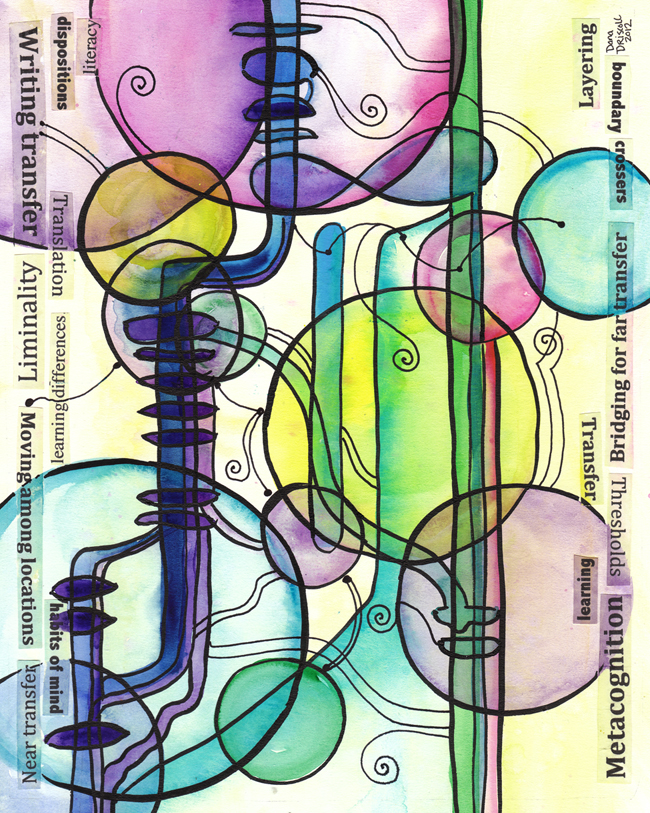Composition Forum 26, Fall 2012
http://compositionforum.com/issue/26/
Transfer of Learning: A Researcher’s View

“Transfer of Learning: A Researcher’s View”
Mixed Media, 2012
Although researchers define and describe writing transfer in a multitude of often-contradictory ways, I wanted to visually represent writing transfer using some of the more prevalent aspects that we can largely agree upon. First, transfer is a messy, chaotic, and ambiguous process. In this piece, the viewer may be unsure as to what he or she is seeing at first; like the act of measuring and understanding transfer, the piece is not obviously representative. Second, the context or activity system that writers inhabit is critically important to understanding transfer. The large, colorful spheres and other assorted shapes represent these contexts; the use of translucent watercolor shows how these spheres overlap and inform each other. Activity theorists Tuomi-Gröhn & Engeström (2003) suggest that when individuals deal with contradictions between activity systems, both individuals and activity systems may change as part of this process—one aspect indicated by the overlap. Third, time is of critical importance; this is why transfer research is often longitudinal and why we focus on activating prior knowledge or encouraging forward-reaching knowledge in transfer-focused pedagogy. The vertical lines in this piece represent the passage of time in and across various domains—personal, educational, professional, etc. The individual ovals in the timelines represent experiences students may have as time progresses. One obvious linear experience is their progress through the educational system—which may or may not be connected to anything in other contexts. Fourth, there is still much to still uncover about writing transfer; the black lines and spirals represent these “unknowns.” They are those bits of data we have but don’t understand; the hunches and hypotheses we formulate; the connections we suspect but haven’t yet discovered. A final aspect that transfer we can agree upon is that because of transfer’s complexity, any model or representation of transfer will be incomplete. As I discovered in painting and sketching several pieces as possible contributions for this special issue, not only is visually representing transfer a challenge for research, but also, for art.
Text description
This image is an abstract piece of art that represents writing transfer. It has colorful spheres and shapes of varying sizes that overlap. The shapes are connected with a series of colorful vertical lines. Small black lines and swirls connect the spheres and vertical lines in a random fashion. Along the edges of the piece, words relating to transfer appear. The words include: writing transfer, dispositions, literacy, translation, liminality, learning differences, moving among locations, habits of mind, and near transfer.
“Transfer of Learning: A Researcher’s View” from Composition Forum 26 (Fall 2012)
Online at: http://compositionforum.com/issue/26/transfer-learning-artwork.php
© Copyright 2012 Dana Lynn Driscoll.
Licensed under a Creative Commons Attribution-Share Alike License.
